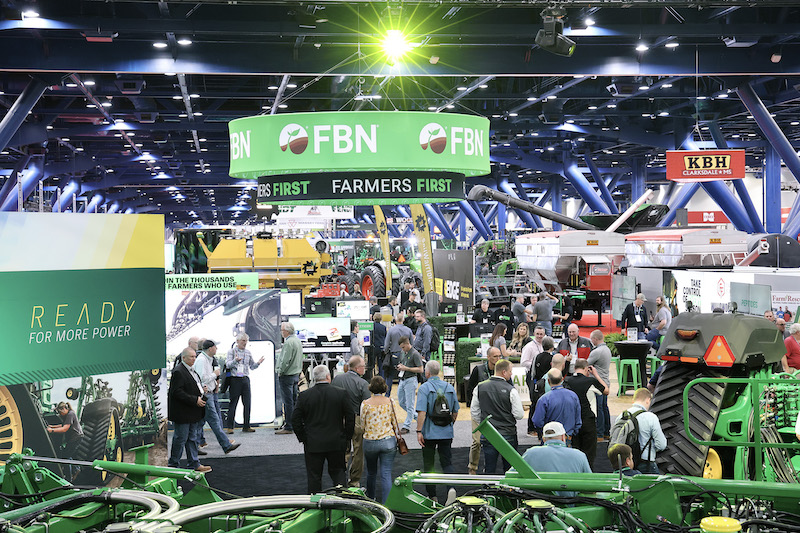After the US lost its status as the world’s top exporter of crops over the past decade, its farmers are ready to fight back. The strategy: maximizing production.
That’s the message from participants at the Commodity Classic in Houston, one of the world’s largest farming shows that saw record attendance of more than 11,500 people two weeks ago. The thought is that even with abundant stockpiles, and corn and soy futures languishing near three-year lows, farmers have little choice but to raise the biggest crops possible.
The US Department of Agriculture projections show farmers are set to maintain elevated planting, which could result in one of the biggest supply expansions ever. While that is expected to send net farm income tumbling 26% this year, it could also help the US regain some ground in the export market.
“You just build stocks and get really cheap corn, so that you force the buyers’ hand to go here because we have very competitively priced corn,” Stephen Nicholson, vice president of grain and oilseeds at farm lender Rabobank, said at the trade show. That “would set us up to be prepared to move more corn offshore.”

The US handed the corn-exporting crown to Brazil last August after dominating the international market for more than half a century. It had already relinquished the top spots in both soybean and wheat exports over the past decade — to Brazil and Russia, respectively.
Lining up to help farmers at the Commodity Classic were machinery companies including Deere & Co., as well as seed and chemical suppliers. As attendees sampled free soy lattes and popcorn, the companies tweaked their marketing plans with appeals to improve efficiency and reign in costs in a slumping farm economy.
“It’s an excellent opportunity for end users to get stocked up,” said Stan Nelson, a farmer in southeastern Iowa who serves as president of the Iowa Corn Promotion Board. He has no plans to pare back plantings, even though he’s already feeling the “burdensome supply.”
To spur the agriculture markets — and its own revenue — Deere has introduced a starter bundle to attract farmers who may not be ready to buy its top-of-the-line machines. For $2,000, farmers can get Deere’s latest computer display, modem and satellite receiver with the option to pay for additional automation features that give more control over tractors.
“What we’re finding is the lower upfront costs attract customers that we haven’t interacted with ever, or within the last decade,” said Than Hartsock, Deere’s vice president of precision upgrades. That includes Hartsock’s father, an Ohio farmer who added the bundle to a Deere model from 1977. “This was just an easy way for him to get back up to speed.”
Kurt Coffey, of Deere rival CNH Industrial NV, says farmers aren’t as concerned about which of the top brands they are buying.
“We hear this a lot from customers: there’s less brand loyalty, and they’re more focused on how does this keep me in the black,” said Coffey, who is North America vice president of CNH’s Case IH brand.
Other companies at the show focused on helping farmers become more sustainable. US startup Indigo Ag Inc. is paying farmers carbon credits for planting cover crops and reducing tillage — practices that improve soil health and eventually boost yields. It’s also introducing 30 new biological crop additives to bolster harvests.
“I know how much of a difference the razor-thin margins are that farms operate on, so when I see commodity prices coming down, I cringe for the farmers,” said Indigo Ag Chief Executive Officer Dean Banks. “What I hope is that the value proposition of our biological products, ultimately, pay for themselves in yield.”
Meanwhile, Farmers Business Network is offering 0% financing for growers who purchase from its network of warehouses in the US and Canada.
Farmers are limiting loans from traditional lenders in hopes interest rates go down. “So that makes the 0% even more helpful for borrowers,” according to Charles Baron, co-founder and chief marketing officer of the startup.
Political Push
The efforts come as the agriculture industry also presses for government action. Industry groups in November backed a proposal for the President’s Export Council, an advisory committee on international trade, to bolster American agriculture’s global standing. The proposal included calls to diversify agricultural supply chains, eliminate trade barriers and enforce existing trade agreements.
At the Commodity Classic, the focus was on the farmers, helping them become more efficient and increase output.
“The fastest way to cut the cost of production is to raise yields,” said Matt Bennett, an Illinois farmer and analyst at AgMarket.net.

Follow us on social media: